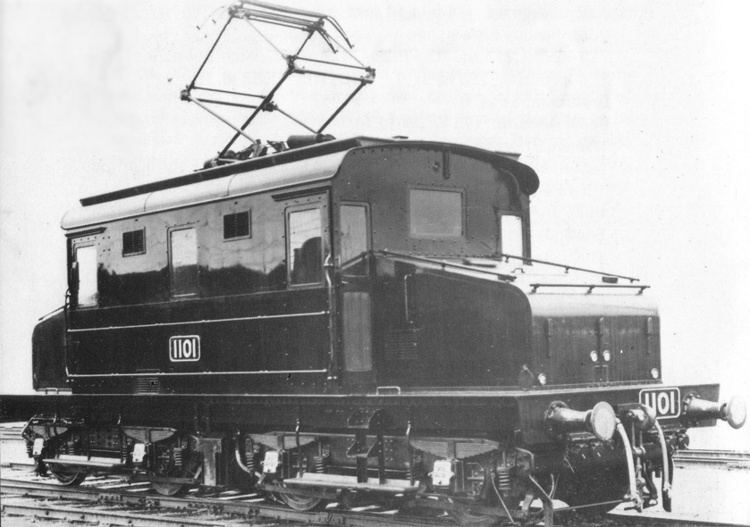Power type Electric UIC class Bo'Bo' | Build date 1923–1929 Gauge 5 ft 3 in (1,600 mm) | |
 | ||
Length 36 ft 4 ⁄2 in (11,090 mm)(steeplecab)39 ft 2 ⁄2 in (11,950 mm)(boxcab) | ||
The Victorian Railways E class was a class of electric locomotive that ran on the Victorian Railways from 1923 until 1984. Introduced shortly after the electrification of the suburban rail system in Melbourne, Australia, and based on the same electrical and traction equipment as Melbourne's early suburban electric multiple unit fleet, they provided power for suburban goods services and shunting for six decades.
Contents
History
With the rapid expansion of Melbourne's suburban electrification scheme, becoming by 1924 the largest in the world at 346 miles (557 km), the Victorian Railways decided to utilise the advantages of electric traction for suburban goods services, which until then had been hauled by steam locomotives such as the Y class 0-6-0, E class 2-4-2T and later Dde class 4-6-2T.
In 1923 it introduced two electric locomotives of 620 hp (460 kW), built at VR's Newport and Jolimont Workshops with the same General Electric traction motors and related electrical equipment that had been installed in Melbourne's Tait and Swing Door electric suburban train sets.
Production
The first two locomotives were built with a steeplecab-style appearance. Despite their appearance and unlike other steeplecab locomotives, they also included a large amount of the electrical equipment including the dynamotor in the driver's cab. The exposure of the driver to this electrical equipment led to them being nicknamed "electric chairs" among drivers.
A further ten locomotives were built in 1928-29 with similar electrical equipment, but on a longer frame with enclosed cabs at each end.
Until the later introduction of the L class Co-Co electric locomotives in 1953, these locomotives were simply known as "Electric Locomotives Nos 1100 to 1111", there being no others in the VR fleet. With the E class steam locomotives withdrawn by the 1950s, the ten box-cab locomotives 1102 to 1111 took the E class designation to differentiate them from the L class fleet. Steeple cabs 1100 and 1101 only ever wore a number, not a letter classification.
Regular service
Upon introduction, the two steeple-cab locomotives proved the superiority of electric traction. They were able to operate together with multiple-unit train control, allowing a single crew to control both as an articulated locomotive with greater tractive effort than the Victorian Railways C class heavy goods locomotive, the most powerful locomotive on the VR at the time. Based on their success, suburban goods sidings were rapidly electrified and most suburban goods traffic utilised electric traction. With the electrification of the Gippsland line as far as Traralgon in the 1950s, the range of the E class locomotives was similarly extended and they could be found shunting or hauling services along the line.
Locomotives 1100 to 1111 were painted in a plain black livery, matching that of the VR steam locomotive fleet. During the 1960s the ten box-cabs were painted in a variation of the blue and gold livery applied to the VR diesel fleet. The locomotives were initially based at the Jolimont Workshops along with the suburban electric multiple unit fleet, as steam locomotives were housed at the North Melbourne Locomotive Depot. However with the opening of the new South Dynon Locomotive Depot in 1964, the entire E class fleet was relocated there in June 1968.
Demise
The first two steeple-cab locomotives were scrapped in July 1955, deemed uneconomic to upgrade with new electrical and coupling equipment. By this time, the electric locomotive fleet had been substantially expanded with 2,400 hp (1,790 kW) L class locomotives of a far more modern design.
The box-cab E class locomotives continued in service. However, during the 1970s, Victorian Railways conducted detailed studies of goods traffic and found that handling costs made the transport of high rated, small freight items unprofitable. As a result of these studies, rail freight operations were rationalised around block trains carrying bulk freight such as gravel, rice or grain, and suburban goods sidings were closed in favour of road freight service. Furthermore, the use of block trains greatly reduced the need for shunting locomotives. These operational changes rendered the ageing E class suburban electric locomotives surplus, and by 1981 scrappings had commenced. The last was withdrawn from service in 1984.
Preservation
Four E class locomotives have survived into preservation. As of May 2007, their disposition was as follows:
